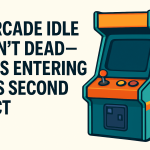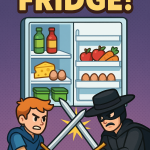It’ll Create Its Own.
Since I started studying the market, I see we’re entering a strange moment in mobile gaming. Puzzle, runner, idle, merge… every dominant hyper-casual or hybrid-casual genre is either saturated, stagnant, or heavily templatized. You can feel it: the clones are cleaner, the ads sharper, the LTV strategies more refined and an ever increasing difficulty to stand out is inevitable. But truly breakout new games? Scarce.
Here’s the thesis:
The next $100M hybrid-casual hit won’t come from perfecting a known genre. It’ll come from fusing mechanics in ways no one’s labeled yet.
Let’s unpack what that means—and why the old genre labels are starting to get in the way.
Templatization Is a Ceiling, Not a Strategy
“Innovation is not about creating something completely new, it’s about finding new ways to approach the familiar.” — Shigeru Miyamoto
Idle + merge. Puzzle + deco. Arcade + RPG-lite. We’ve seen the formulas. Many work. But that’s the problem: they only work.
Publishers and studios love predictability—but players don’t. And what was once innovative (Archero’s roguelite loop, Mob Control’s multiplier stacking) is now industry standard.
Why this matters: A known genre fusion is easy to sell to a publisher—but harder to differentiate in the market.
To stand out in 2025+, you need gameplay that forces a double-take. A hook that’s both familiar and fundamentally odd.
We’ve recently seen this in practice—with Solitaire. A mechanic that’s decades old, universally understood, and almost too familiar. But precisely because of that, it holds untapped potential when fused creatively. Just look at what specially Playtika have done: Solitaire + Deco, Solitaire + Merge, Solitaire + RPG-lite. These games are thriving—not because Solitaire is new, but because it’s been remixed in ways that create something fresh. Their success proves the point: the next wave isn’t about inventing new mechanics, but about combining the familiar in unfamiliar ways.
Fusion as Innovation: Where the Edges Blur
Here’s what I’m seeing from user behavior, emerging titles, and market gaps:
| Fusion Type | What It Looks Like | Why It Works |
|---|---|---|
| Idle + Social PvP | Collect → Upgrade → Auto-Battle leaderboard AI clones | Adds drama, progression, and spectatability to solo loops |
| Puzzle + Farming Sim | Solve spatial logic to unlock/plant/manage a living environment | Turns skill into strategy → long-term ownership |
| Narrative + ASMR Gamefeel | Light story arcs gated by tactile interactions (e.g., organizing, trimming, repairing) | Story fuels retention; ASMR fuels CPI |
| Tamagotchi-lite + PvE Defense | Care for a creature who defends your base when you’re offline | Emotional bond meets tactical payoff |
| Crafting + Vertical Action | Mid-session construction impacts the moment-to-moment gameplay (think Jetpack Joyride x Minecraft-lite) | Creative agency + skill expression = TikTok magic |
This isn’t genre-hopping. It’s genre fusion—deliberately designing tension between mechanics.
🔥Why Fusion Wins in 2025
- Better CPI Creative
- Fusion creates contrast: hard vs soft, peaceful vs chaotic. These juxtapositions make ads pop.
- Think: “Watch me organize this fridge to win a sword fight.”
- Longer Retention Arcs
- Fusion games stretch players across motivations. One session they chase mastery, the next they decorate or explore.
- This fuels cross-session identity—a core driver of hybrid retention.
- Deeper Monetization Funnels
- Hybrid monetization is about segmenting intent. A fused game can monetize collectors and min-maxers in the same economy.
🎯Designing the “Unlabeled” Game: What to Ask
As a simple playbook, before you prototype your next hyper-casual or hybrid-casual title, ask this:
- Does this game exist under any current App Store category? If yes, push harder.
- Can a TikTok ad show two emotions or two mechanics in 6 seconds?
- Does the player’s motivation shift across sessions?
- Would someone need a sentence—not a genre—to explain it?
If the answer to any of those is yes, you’re on the right track. You will see it’s not an easy task (at least for me it is, since my creativity is limited).
💡 What This Looks Like in Practice
You don’t need to build all systems at once. Here’s what to prototype in Week 1 of a fusion-driven hybrid:
| Element | What to Prove |
|---|---|
| 🎮 Core Loop | Two distinct systems interact (e.g. puzzle affects idle, narrative affects upgrades) |
| 🎥 CPI Hook | Visual twist: “Wait—what kind of game is this?” |
| 🧠 Meta Signal | Clear potential for long-term systems (progression, collection, risk) |
| 🧪 Monetization Angle | At least one monetizable loop with friction+desire (e.g. boosters, auto-play, visual skins) |
You’re not trying to perfect genre X or Y. You’re trying to invent genre XY.
Final Thought: The Market Is Bored. You Shouldn’t Be.
The top of the charts is crowded with polished clones. That’s a sign of maturity—but also opportunity. In this sea of sameness, even small novelty scales. Especially if it’s structured, satisfying, and strange enough to not fit in a pitch deck… yet.
So forget building the next merge-something. Build something no one knows how to name—yet everyone knows how to play.
If this idea clicks, DM me, I’ll be happy to talk. Let’s talk genre fusion, retention systems, or how to design for the weird edge of hybrid.


